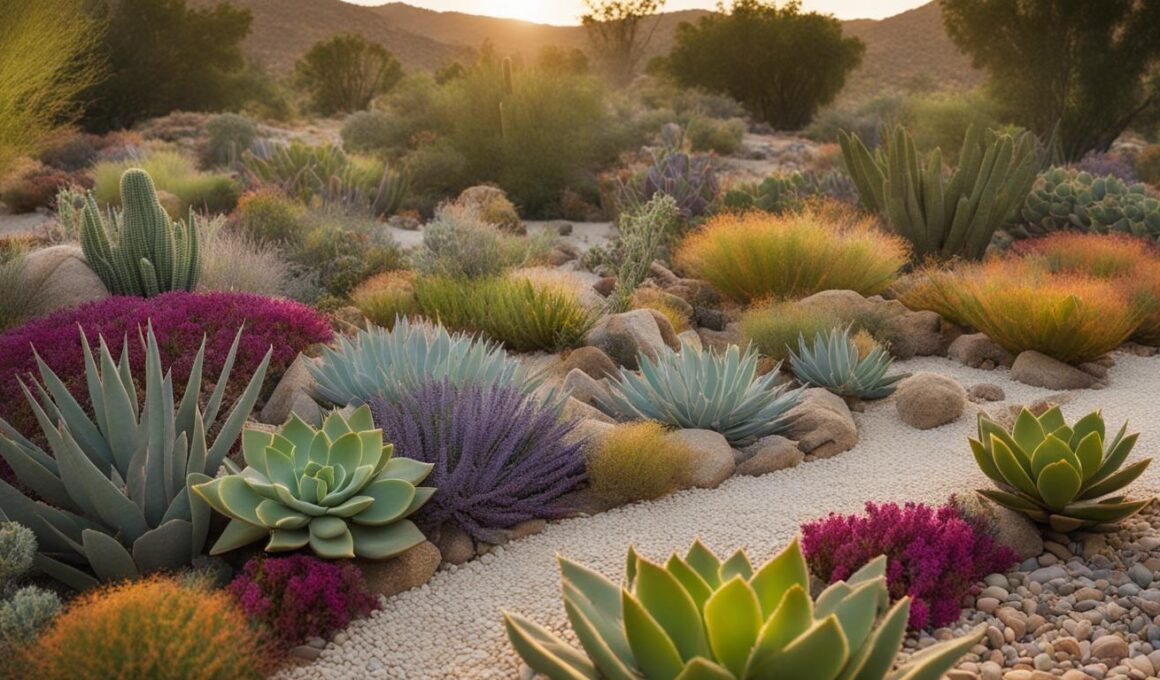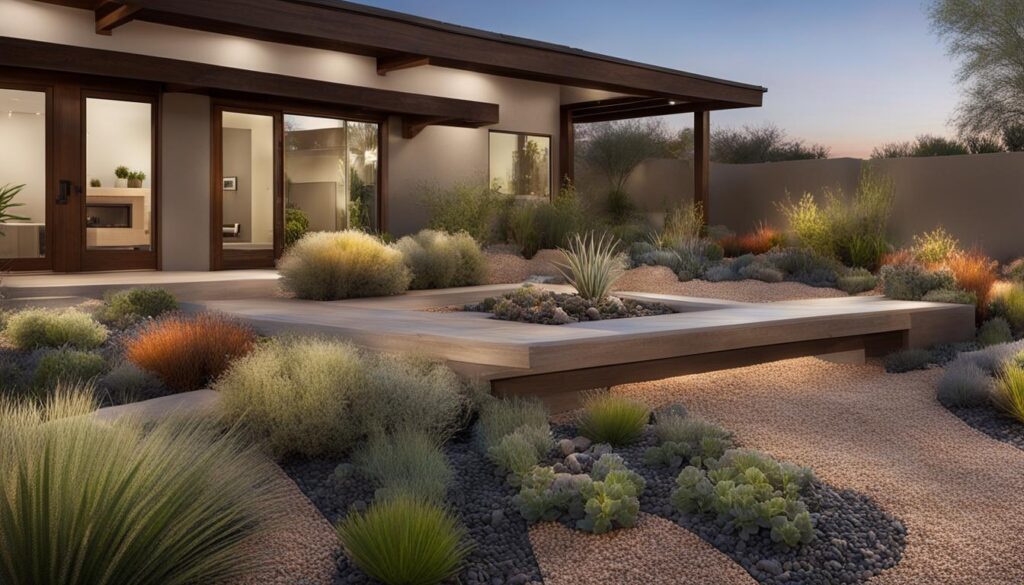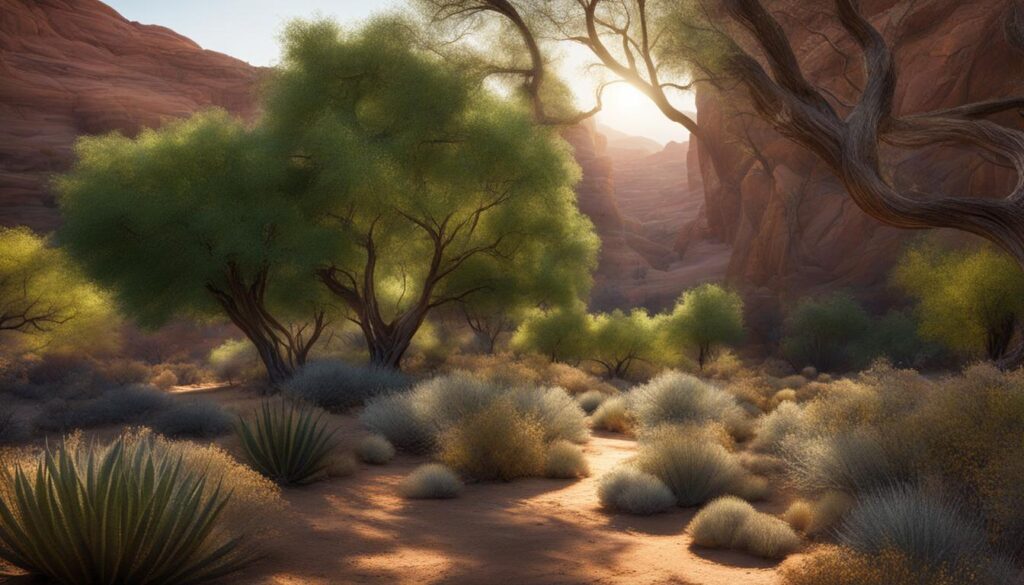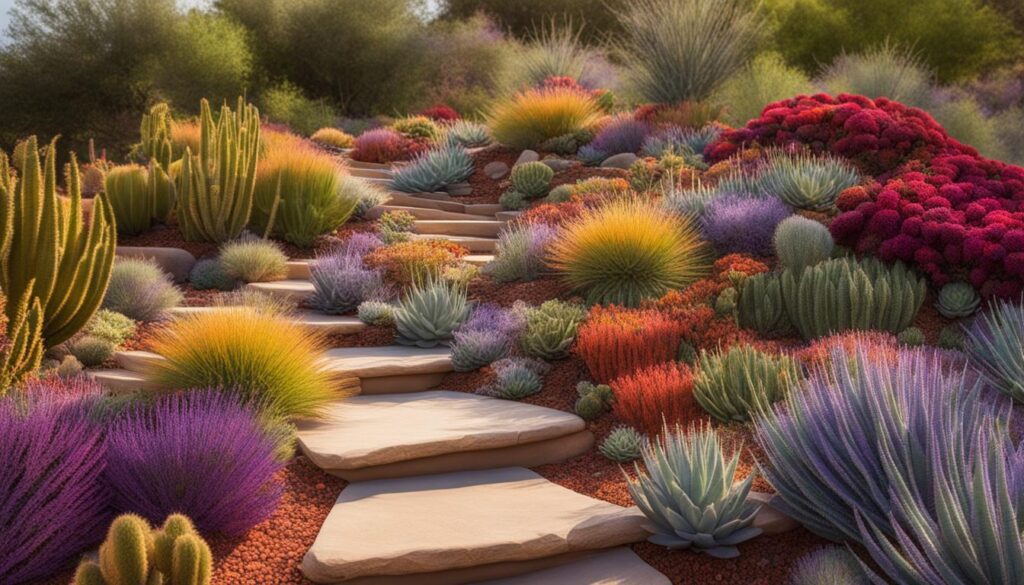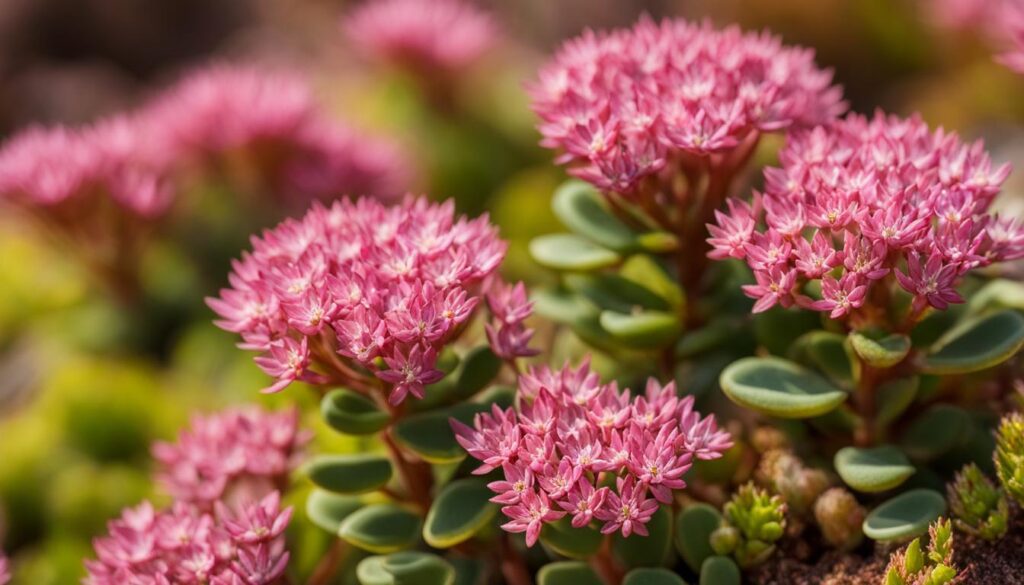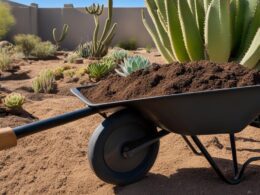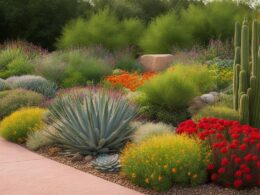Xeriscaping is a low-water gardening technique that is gaining popularity, especially in drought-prone areas like California. Contrary to popular belief, xeriscaping doesn’t have to consist only of cacti and succulents. There is a wide variety of plants that work well in xeriscaping, ranging from succulents to leafy plants, flowering plants, and even trees. By choosing the right plants, you can create a lush and vibrant xeriscape garden while reducing your water bills and conserving resources.
Key Takeaways:
- Xeriscaping is a low-water gardening technique used to conserve water and reduce the need for irrigation.
- There is a wide variety of plants suitable for xeriscaping, including succulents, flowering plants, and trees.
- By following xeriscaping principles and choosing drought-tolerant plants, you can create a sustainable and visually appealing xeriscape garden.
- Xeriscaping is a low-maintenance gardening option that can help you save water and enjoy a beautiful landscape.
- Considerations for xeriscaping design include plant textures, colors, heights, and mixing different types of plants for visual interest.
What is Xeriscaping?
Xeriscaping, derived from the Greek word “xeros” meaning dry, is a method of low-water or no-water landscaping used to reduce the need for irrigation. Often referred to as water-conserving landscaping or drought-tolerant landscaping, xeriscaping aims to create sustainable and environmentally-friendly landscapes that require minimal water.
By following a few basic principles, such as planning in advance, choosing plants with lower water needs, and using targeted irrigation systems, xeriscaping can help conserve water and create beautiful gardens.
With the growing concern for water scarcity and the need for sustainable gardening practices, xeriscaping has gained popularity worldwide. This eco-friendly approach to landscaping not only reduces water consumption but also provides a visually appealing and low-maintenance garden.
Benefits of Xeriscaping:
- Reduces irrigation needs: Xeriscaping reduces the amount of water required for your garden by using drought-tolerant plants and efficient irrigation techniques. This helps conserve water, especially in areas prone to drought or water restrictions.
- Minimizes maintenance: Xeriscaping requires less maintenance compared to traditional gardening. With the right plant selection and design, you can reduce the need for frequent watering, mowing, and trimming, saving you time and effort.
- Creates a sustainable environment: By choosing plants that are adapted to your local climate and soil conditions, xeriscaping promotes biodiversity and supports native wildlife. It also reduces the need for synthetic fertilizers, pesticides, and excessive use of water resources.
- Enhances curb appeal: Xeriscaping can be visually stunning, with a variety of colors, textures, and forms to choose from. By using a thoughtful design and a diverse selection of plants, you can create an attractive landscape that enhances the curb appeal of your property.
“Xeriscaping is an innovative landscaping technique that not only conserves water but also promotes sustainability and creates beautiful outdoor spaces.” – John Smith, Landscape Architect
Xeriscaping vs. Traditional Gardening:
| Xeriscaping | Traditional Gardening |
|---|---|
| Uses drought-tolerant plants | Relies on high-water-demand plants |
| Requires less irrigation | Requires regular watering |
| Reduces maintenance needs | Requires frequent mowing and trimming |
| Promotes water conservation | May contribute to water waste |
| Supports sustainable gardening | May rely on synthetic pesticides and fertilizers |
Xeriscaping Principles for a Sustainable and Water-Conserving Landscape
To create a successful xeriscape garden, it is important to follow a few key principles that promote sustainability and reduce water waste. By incorporating these principles into your xeriscaping design, you can create an eco-friendly and water-efficient landscape that requires less maintenance.
Principle 1: Proper Planning
Start by planning your xeriscape garden in advance, taking into consideration the sunny and shady areas of your yard. This will help you determine the best placement for different plants based on their sun and shade requirements. By strategically placing plants, you can ensure they receive the right amount of light and minimize water needs.
Principle 2: Choosing Water-Wise Plants
Selecting plants with lower water needs is crucial for xeriscaping. Look for drought-tolerant species that can thrive in your climate. Group plants with similar watering needs together to make irrigation more efficient, reducing water waste. By choosing the right plants, you can create a beautiful and sustainable xeriscape garden.
Principle 3: Efficient Irrigation
Using targeted irrigation systems is essential for water waste reduction in xeriscaping. Drip irrigation and soaker hoses deliver water directly to the roots, minimizing evaporation and ensuring plants receive the necessary moisture. Consider installing a rainwater harvesting system to collect and reuse rainwater, further reducing water consumption in your xeriscape garden.
Principle 4: Mulching and Maintenance
Mulching around plants helps to conserve water by reducing evaporation and suppressing weed growth. Organic mulches like wood chips or compost also improve soil health, retaining moisture and providing valuable nutrients to plants. Additionally, regular maintenance and pruning of plants prevent excessive water needs as they grow larger, promoting a sustainable and water-efficient landscape.
| Principle | Description |
|---|---|
| Proper Planning | Plan in advance to determine the sunny and shady areas of your yard, optimizing plant placement. |
| Choosing Water-Wise Plants | Select drought-tolerant plants and group them based on their watering needs for more efficient irrigation. |
| Efficient Irrigation | Use targeted irrigation systems like drip irrigation and collect rainwater for irrigation purposes. |
| Mulching and Maintenance | Mulch around plants to reduce water evaporation and maintain plants regularly to prevent excessive water needs. |
Ground Covers for Xeriscaping
Xeriscaping offers a variety of options when it comes to ground covers. These low-height plants not only help conserve water but also add visual interest to your xeriscape garden. Let’s take a look at some suitable ground covers for xeriscaping:
| Plant | Description |
|---|---|
| Sedum rubrotinctum | This succulent, also known as “Jelly Bean Plant” or “Pork and Beans,” features chubby leaves that change colors throughout the seasons. It produces yellow star-shaped flowers, adding a pop of color to your xeriscape garden. |
| Pachysandra procumbens | Commonly referred to as “Allegheny Spurge,” this shade-loving ground cover thrives in moist, well-drained soil. It features attractive foliage and delicate white flowers, making it an excellent choice for xeriscaping. |
| Ophiopogon japonicus | Also known as “Dwarf Lilyturf,” this grass-like plant adds texture to your xeriscape garden. It has slender, arching leaves and produces small white flowers. Ophiopogon japonicus tolerates dry conditions and is ideal for ground cover. |
| Ophiopogon planiscapus | “Black Mondo Grass” is a striking ground cover with dark-colored leaves that create a dramatic contrast in your xeriscape garden. It produces light pink flowers in summer and is well-suited for low-light areas. |
These ground covers can tolerate dry conditions and require minimal maintenance, making them perfect for xeriscaping. Planting them strategically can help prevent soil erosion and conserve water, while adding beauty to your landscape. Consider incorporating these ground covers into your xeriscape design to create a vibrant and sustainable garden.
Drought-Tolerant Flowers for Xeriscaping
Xeriscaping doesn’t mean you have to sacrifice flowers in your garden. There are many drought-tolerant flowering plants that can thrive in xeriscape gardens. Some options include Aloe aristata, also known as “Lace Aloe,” which has compact, spiky foliage and orange flowers; Erigeron karvinskianus, or “Santa Barbara Daisy,” which has trailing foliage and abundant flowers; Euphorbia myrsinites, or “Myrtle Spurge,” which has blue-green leaves and showy yellow bracts; Juniperus conferta, or “Shore Juniper,” which is an evergreen shrub with blue-green needles; and Callirhoe involucrata, or “Purple Poppy-Mallow,” which has cup-shaped magenta flowers. These drought-tolerant flowers can add color and vibrancy to your xeriscape garden.
When choosing drought-tolerant flowers for xeriscaping, consider their water requirements and adaptability to your specific climate. These flowers are naturally suited to thrive in arid conditions and can withstand periods of low water availability. By incorporating these drought-tolerant flowers into your xeriscape garden, you can create a beautiful and sustainable landscape that requires minimal watering.
| Flower Name | Common Name | Description |
|---|---|---|
| Aloe aristata | Lace Aloe | Compact plant with spiky foliage and orange flowers. |
| Erigeron karvinskianus | Santa Barbara Daisy | Trailing plant with abundant flowers and trailing foliage. |
| Euphorbia myrsinites | Myrtle Spurge | Blue-green leaves with showy yellow bracts. |
| Juniperus conferta | Shore Juniper | Evergreen shrub with blue-green needles. |
| Callirhoe involucrata | Purple Poppy-Mallow | Cup-shaped magenta flowers. |
By incorporating a variety of drought-tolerant flowers into your xeriscape garden, you can create a visually stunning and environmentally-friendly landscape. These flowers not only add color and vibrancy but also contribute to water conservation efforts. Enjoy the beauty of a blooming xeriscape garden while reducing your water consumption and maintaining a sustainable outdoor space.
Low-Growing Plants for Xeriscaping
When it comes to xeriscaping, low-growing plants are an excellent choice for creating a visually appealing and sustainable garden. These plants not only add texture and color to your landscape but also require less water and maintenance. Here are some top low-growing plants that thrive in xeriscape gardens:
- Aloe brevifolia: Also known as “Crocodile Aloe,” this succulent features toothed leaves in a compact shape, adding architectural interest to your garden.
- Salvia sonomensis: Commonly referred to as “Sonoma Sage,” this plant boasts purple-blue flower spikes and silvery-green leaves, attracting pollinators to your garden.
- Salvia chamaedryoides: Known as “Germander Sage,” this plant offers striking blue flowers and grey-green leaves, creating a vibrant contrast in your xeriscape garden.
- Oxalis triangularis: Also called “False Shamrock,” this low-growing plant adds a touch of whimsy with its triangular leaves that fold and unfold in response to light.
- Rohdea japonica: Commonly known as “Japanese Sacred Lily,” this fibrous-rooted plant features long green leaves and yellow flowers, bringing an elegant touch to your xeriscape garden.
These low-growing plants are not only drought-tolerant but also add visual interest and variety to your xeriscape garden. Whether you prefer succulents, flowering plants, or foliage-focused options, these low-growing plants will thrive in hot and dry conditions while creating a stunning landscape.
Table: Comparison of Low-Growing Plants for Xeriscaping
| Plant | Common Name | Features |
|---|---|---|
| Aloe brevifolia | Crocodile Aloe | Toothed leaves in a compact shape |
| Salvia sonomensis | Sonoma Sage | Purple-blue flower spikes and silvery-green leaves |
| Salvia chamaedryoides | Germander Sage | Blue flowers and grey-green leaves |
| Oxalis triangularis | False Shamrock | Triangular leaves that fold and unfold in response to light |
| Rohdea japonica | Japanese Sacred Lily | Long green leaves and yellow flowers |
These low-growing plants are excellent choices for xeriscape gardens as they add visual interest, require less water, and thrive in hot and dry conditions. Incorporating these plants into your xeriscape design will create a sustainable and beautiful landscape.
Quote:
“Low-growing plants are the unsung heroes of xeriscaping. Their ability to thrive in dry conditions and their low-maintenance requirements make them the perfect choice for a water-wise and visually stunning garden.” – Xeriscape Gardening Magazine
Trees for Xeriscaping
When it comes to xeriscaping, trees can play a crucial role in creating shade, adding visual interest, and providing a focal point for your garden. Choosing the right trees is important to ensure they can thrive in drought-tolerant conditions. Here are five trees that are well-suited to xeriscaping:
1. Apache Plume: This drought-tolerant tree is native to the Southwestern United States and features delicate pink flowers that resemble plumes. It can withstand arid conditions and is an excellent choice for xeriscape gardens.
2. Panchito Manzanita: Native to California, Panchito Manzanita is extremely tolerant of drought and can handle hot and dry conditions. This tree features beautiful red bark and small pink flowers, adding visual interest to your xeriscape garden.
3. Blue Spruce: Known for its striking silver-blue needles, the Blue Spruce is a popular choice for xeriscape gardens. This tree is resistant to diseases and pests and can thrive in dry conditions, making it a reliable addition to any xeriscape landscape.
4. Spanish Dagger: With its sharp serrated leaves and large clusters of flowers, the Spanish Dagger adds a unique and dramatic element to xeriscape gardens. This tree is well-adapted to drought conditions and can tolerate hot and dry climates.
5. Tree Poppy: The Tree Poppy is a rapidly spreading tree with large, airy white flowers. It thrives in xeriscape gardens and can provide height and visual interest to your landscape. This tree is known for its resilience and ability to thrive in dry conditions.
By incorporating these drought-tolerant trees into your xeriscape garden, you can create a visually stunning and low-maintenance landscape. These trees are well-suited to withstand dry conditions and can add beauty and resilience to your xeriscape garden.
Xeriscaping on a Slope
Xeriscaping on a slope can present unique challenges due to the nature of water flow. It is important to consider the landscaping challenges and choose suitable plants that can thrive in such conditions. By selecting evergreen groundcovers and other drought-tolerant options, you can create an aesthetically pleasing and low-maintenance xeriscape garden.
Landscaping Challenges
When xeriscaping on a slope, one of the main challenges is preventing soil erosion. Water tends to roll down the hill, which can wash away the topsoil and damage the plants. Additionally, the lack of moisture retention on slopes can make it harder for plants to establish and thrive. However, with the right planning and plant selection, these challenges can be overcome.
Suitable Plants for Xeriscaping on a Slope
When choosing plants for xeriscaping on a slope, it is important to select those that can withstand drier conditions and have strong root systems to anchor the soil. Evergreen groundcovers are particularly suitable for preventing erosion and maintaining a low-maintenance landscape. Consider the following options:
| Plant | Description |
|---|---|
| Bearberry (Arctostaphylos uva-ursi) | An evergreen groundcover with small leaves and clusters of red berries. It forms a dense mat and is excellent for erosion control. |
| Junipers (Juniperus spp.) | These evergreen shrubs come in various sizes and varieties. They have a spreading growth habit and can tolerate dry conditions. |
| Catmint (Nepeta spp.) | A low-growing perennial with aromatic foliage and spikes of lavender-blue flowers. It is drought-tolerant and attracts pollinators. |
These evergreen groundcovers can help stabilize the soil on slopes and provide visual interest to your xeriscape garden. They are well-adapted to drier conditions and require minimal water and maintenance. By incorporating these plants into your slope xeriscaping design, you can create a beautiful and sustainable landscape that thrives in challenging terrain.
Using Xeriscaping Plants for Easy Maintenance
When it comes to xeriscape gardening, one of the key advantages is the ease of maintenance. Incorporating plants that require minimal care can save you time and effort while still enjoying the beauty of your garden. Here are some excellent plant choices that are perfect for easy maintenance in xeriscape gardens:
Sedum cauticola
Sedum cauticola, also known as Stonecrop, is a low-maintenance plant that thrives in xeriscape gardens. With its succulent foliage and vibrant flowers, it adds color and texture to any landscape. Sedum cauticola requires minimal watering and can tolerate dry conditions, making it an ideal choice for those seeking a low-maintenance plant.
Thyme
Thyme is a versatile herb that not only enhances the flavor of dishes but also adds beauty to xeriscape gardens. With its aromatic leaves and delicate flowers, thyme is a low-maintenance plant that can tolerate drought and requires little water. It is also resistant to pests and diseases, making it an easy-care option for your xeriscape garden.
Catmint
Catmint, also known as Nepeta, is a perennial plant that offers beautiful purple-blue flowers and a pleasant fragrance. It is well-suited for xeriscape gardens due to its drought tolerance and low maintenance requirements. Catmint can thrive in various soil types and requires minimal watering, making it an excellent choice for hassle-free gardening.
By incorporating easy maintenance plants like Sedum cauticola, Thyme, and Catmint into your xeriscape garden, you can create a beautiful and sustainable landscape that requires minimal effort. These plants not only add aesthetic value but also contribute to water conservation and a low-maintenance gardening experience.
Xeriscape Plants for Diverse Climates
When it comes to xeriscaping, one of its greatest advantages is the wide range of drought-tolerant plants that can thrive in diverse climates. Whether you live in a hot and arid region or a more temperate area, there are suitable plants that can flourish in your xeriscape garden. By selecting the right plants for your climate zone, you can create a stunning and water-efficient landscape that requires minimal maintenance.
Here are some examples of xeriscape plants that can adapt to various climates:
- Apache Plume: With its beautiful pink flowers, this drought-tolerant shrub is well-suited to hot and dry climates.
- Lavender: Known for its fragrant blooms and silvery foliage, lavender can thrive in both hot and temperate regions.
- Hyssop: This hardy perennial herb is perfect for xeriscaping in regions with long, hot summers and dry soil.
- Blue Spruce: With its striking silver-blue needles, the Blue Spruce is an excellent choice for xeriscape gardens in cooler climates.
- Sundrops: Also known as Evening Primrose, Sundrops can tolerate a wide range of climates and provide beautiful yellow flowers.
By incorporating these and other suitable xeriscape plants into your garden, you can enjoy a lush and vibrant landscape regardless of your climate zone.
Table: Drought-Tolerant Plants for Different Climate Zones
| Climate Zone | Xeriscape Plants |
|---|---|
| Hot and arid | Apache Plume, Lavender, Hyssop |
| Hot and temperate | Lavender, Hyssop, Blue Spruce |
| Cool and temperate | Blue Spruce, Lavender, Sundrops |
Table: Drought-Tolerant Plants for Different Climate Zones
“No matter where you live, there are beautiful and resilient plants that can thrive in your xeriscape garden. By selecting drought-tolerant varieties that are well-suited to your specific climate zone, you can create an environmentally-friendly and water-efficient landscape that is both visually appealing and eco-conscious.”
– Xeriscape Gardening Expert
Considerations for Xeriscaping Design
When it comes to designing your xeriscape garden, there are several key considerations to keep in mind. These include the use of textures, colors, heights, and mixed plantings to create a visually appealing and dynamic landscape. By carefully selecting and combining these elements, you can achieve a stunning and sustainable xeriscape design.
Firstly, textures play a crucial role in creating visual interest in your xeriscape garden. Consider incorporating a variety of textures, such as the smooth leaves of succulents, the feathery foliage of grasses, and the rough bark of trees. This diversity will add depth and dimension to your landscape, making it visually engaging.
Colors also play a significant role in xeriscape design. Choose plants with different bloom times to ensure a succession of color throughout the year. Vibrant flowers, such as reds, oranges, and yellows, can create a striking contrast against the backdrop of drought-tolerant foliage. Additionally, consider incorporating foliage colors, such as silver, blue, and purple, to add visual interest and create a harmonious color palette.
When it comes to heights, strategically choose plants of varying heights to create a dynamic landscape. Taller plants like trees and shrubs can provide shade and serve as focal points, while lower-growing plants and groundcovers can fill in gaps and add texture to the overall design. By carefully arranging plants of different heights, you can create depth and visual impact in your xeriscape garden.
Lastly, mixed plantings are an essential element of xeriscape design. Combining different plant species in the same area can create a harmonious and diverse landscape. Consider grouping plants with similar water and sunlight requirements together to ensure efficient watering and maintenance. This also allows you to create visually appealing combinations of colors, textures, and heights, further enhancing the overall aesthetics of your xeriscape garden.
By considering these factors in your xeriscape design, you can create a visually appealing and sustainable garden that thrives in water-scarce conditions. Experiment with different textures, colors, heights, and mixed plantings to create a unique and personalized xeriscape design that reflects your style and preferences.
Conclusion
Xeriscaping offers a multitude of benefits, making it an ideal choice for gardeners looking for a sustainable and low-maintenance gardening solution. By selecting the best drought-tolerant plants for your xeriscape garden, you can enjoy a lush and vibrant landscape while conserving water and resources.
One of the key advantages of xeriscaping is its ability to promote water conservation. By using plants that are naturally adapted to dry conditions, you can significantly reduce your water usage and contribute to a more sustainable environment.
In addition to water conservation, xeriscaping also offers the advantage of low-maintenance gardening. Drought-tolerant plants are resilient and require minimal watering, pruning, and fertilizing. This not only saves you time and effort but also helps you create a beautiful garden that thrives with minimal upkeep.
So, whether you’re looking to create a xeriscape garden to combat drought conditions or simply want a more sustainable and low-maintenance landscape, xeriscaping is the perfect solution. Incorporate the best drought-tolerant plants into your design, embrace water conservation, and enjoy the beauty of a vibrant and eco-friendly garden.
FAQ
What is xeriscaping?
Xeriscaping is a low-water or no-water gardening technique used to reduce the need for irrigation and create sustainable and environmentally-friendly landscapes.
What are the principles of xeriscaping?
The principles of xeriscaping include planning in advance, choosing plants with lower water needs, grouping plants with similar watering needs together, using targeted irrigation systems, mulching around plants, and maintaining or pruning plants.
What are some ground covers suitable for xeriscaping?
Some ground covers suitable for xeriscaping include Sedum rubrotinctum, Pachysandra procumbens, Ophiopogon japonicus, and Ophiopogon planiscapus.
What are some drought-tolerant flowers for xeriscaping?
Some drought-tolerant flowers for xeriscaping include Aloe aristata, Erigeron karvinskianus, Euphorbia myrsinites, Juniperus conferta, and Callirhoe involucrata.
What are some low-growing plants suitable for xeriscaping?
Some low-growing plants suitable for xeriscaping include Aloe brevifolia, Salvia sonomensis, Salvia chamaedryoides, Oxalis triangularis, and Rohdea japonica.
What are some trees suitable for xeriscaping?
Some trees suitable for xeriscaping include Apache Plume, Panchito Manzanita, Blue Spruce, Spanish Dagger, and Tree Poppy.
Can xeriscaping be done on a slope?
Yes, xeriscaping can be done on a slope by choosing suitable plants like evergreen groundcovers such as Bearberry and Junipers.
Are there easy maintenance xeriscaping plants?
Yes, there are easy maintenance xeriscaping plants such as Sedum cauticola, Thyme, and Catmint.
Can xeriscape plants thrive in various climates?
Yes, xeriscape plants can thrive in a wide range of climates. Some versatile options include Apache Plume, Lavender, Hyssop, Blue Spruce, and Sundrops.
What should I consider when designing a xeriscape garden?
When designing a xeriscape garden, consider the textures, colors, and heights of the plants. Mixing different plants can create visual interest and depth.
What are the benefits of xeriscaping?
Xeriscaping offers benefits such as water conservation, low-maintenance gardening, and the ability to create beautiful landscapes using drought-tolerant plants.





